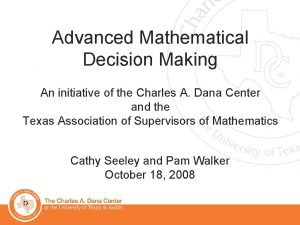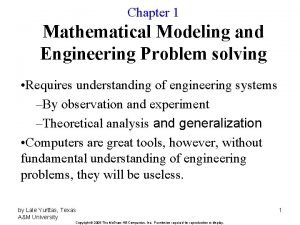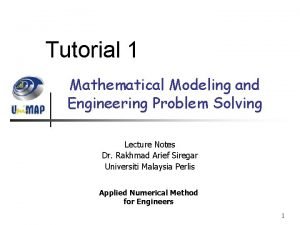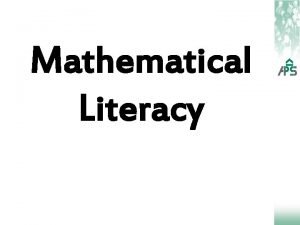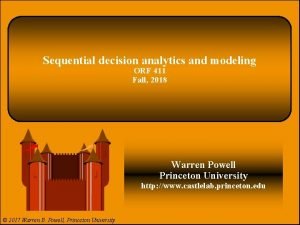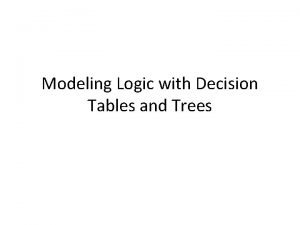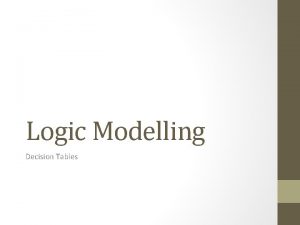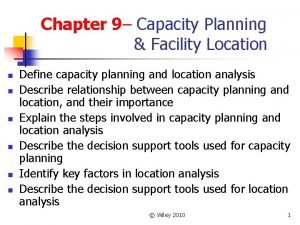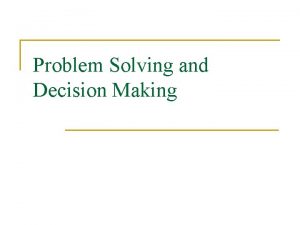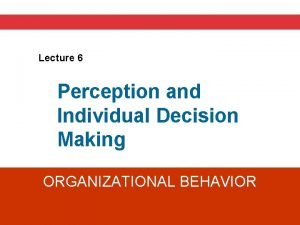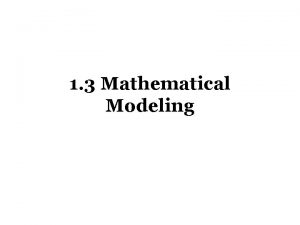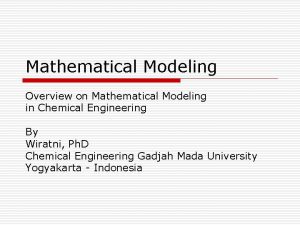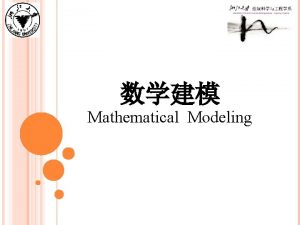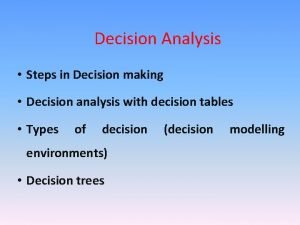Mathematics Mathematical Modeling and Decision Making Jennifer Slimowitz































- Slides: 31

Mathematics, Mathematical Modeling, and Decision Making Jennifer Slimowitz Board on Mathematical Sciences and Their Applications The National Academies August 7, 2004

Outline • National Academies and mathematics • 3 examples of current project areas – Environmental modeling – Molecular biology and genomics – Forensic science August 7, 2004

The National Academies • Provides independent, objective scientific advice to the nation. Convenes scientific workshops and panels of experts who work pro-bono to generate recommendations. • Chartered by Lincoln in 1863 • Comprised of the – – National Academy of Sciences National Academy of Engineering Institute of Medicine National Research Council August 7, 2004

Board on Mathematical Sciences and Their Applications (BMSA) • Mission: to support and promote the quality and health of the mathematical sciences and their benefits to the nation. To do this, we – Conduct studies and meetings and disseminate reports and technical assessments on mathematical sciences topics of national interest; and – Inform and cooperate with various governmental, technical, and public bodies on technical and policy matters relating to mathematical sciences. August 7, 2004

National Academies • Scientific boards deal with real-world issues • “Pure Science” is paired with policy, law, and other practical constraints to help address issues • Scientists play a role in decision-making, but not the only role August 7, 2004

3 Examples of Current Studies • Mathematical models used by the EPA • Molecular biology and genomics • Forensic science August 7, 2004

Mathematical Modeling in the EPA Mission: to protect human health and the environment Uses mathematical models to develop regulatory standards (e. g. for air and water quality) and to determine if proposed construction will be in compliance with regulations Differential equations, statistics, computational science August 7, 2004

Some Questions on the Use of Environmental Models • What are the underlying assumptions of a given model? • How do you aggregate models together? • How do the limitations of the aggregate model compare with those of its components? • How do you responsibly convey the assumptions, limitations, and degree of testing of models? • How do you know of your model is applicable in a certain circumstance? August 7, 2004

Example: Community Multi-scale Air Quality (CMAQ) Model • Approaches air quality as a whole – Ground level ozone – Fine particles – Visibility degradation • Multiple pollutants and multiple spatial scales • Combines chemical, transport, and meteorology models (technically hard!) August 7, 2004

CMAQ (continued) • Used regularly for research and regulatory purposes (mostly ground level ozone) • Involves ODEs and PDEs • Inputs include grid size, temporal and spatial wind vectors, and emissions of pollutants (often coming as outputs from other models) • Outputs include spatial and temporal concentrations of pollutants • Huge and complicated! August 7, 2004

What steps could the EPA follow to evaluate if a model is suitable? • Peer review? Compare to data? Proprietary? Need some kind of quality assurance. • Council for Regulatory Environmental Modeling (CREM) is developing “knowledge data base” to elucidate models that EPA uses. Motto: turn the black box to Plexiglas. • Why is this important to EPA? August 7, 2004

National Academies study in progress: “Environmental Decision Making: Principles and Criteria for Models” Statement of Task includes • provide advice concerning the development of guidelines and a vision of the selection and use of models at the agency • provide a report that will serve as a fundamental guide for the selection and use of models in the regulatory process at the EPA. August 7, 2004

Who sits on the committee to give this type of advice to EPA? Experts in • environmental, chemical, and civil engineering • decision science and risk analysis and assessment • biology • mathematical ecology • transportation and planning • history of science • public policy and law • biostatistics and spatial statistics August 7, 2004

Molecular Biology and Genomics Big Question Given the genome of a given organism, how can you predict behavior? • In humans, we can pinpoint the gene which indicates cystic fibrosis. How comes kids with CF get sick from microbial infections? • Can a good model help us determine how certain genetic mutations affect function? August 7, 2004

Why is this important to policy makers? • Medical: enable the development of new drugs targeted to people with specific mutations • Energy and Environment: engineer or find organisms to aid in carbon sequestration, bioremediation, or production of clean energy August 7, 2004

Role of Mathematics in Molecular Biology and Genomics To identify emergent properties, generate nonobvious hypotheses, and identify missing information by • Developing good models (dynamical systems, differential equations, geometry) • Learning how to analyze massive data sets (statistics, pattern recognition algorithms) August 7, 2004

Example: Statistics involved in gene expression analysis Traditionally, statistics deals with a few independent observations taken from many samples. In gene expression analysis, we have many dependent observations taken from only a few samples. Requires new techniques! Is it a vanity plate or just a coincidence? August 7, 2004

National Academies Study in Progress: “Mathematical Sciences Research for DOE’s Computational Biology” Statement of Task: “recommend mathematical sciences research activities to the Department of Energy that will enable science to make effective use of the large amount of existing genomic information and the much larger and more diverse collections of structural and functional genomic information that are being created” August 7, 2004

Who sits on the committee to give this type of advice? Experts in • genetics, population genetics, and plant biology • statistics, computational science, mathematical ecology, mathematical physiology, and bioinformatics • neuroscience • chemical engineering and chemical physics August 7, 2004

Quote from a committee member: “Relationships between phenotype and genotype are inherently difficult because of the subtlety involved. If mechanisms were big and obvious, organisms with mutations would not survive. ” August 7, 2004

Forensic Science • DNA forensic testing (success story!) • Bullet lead analysis False positives vs. False negatives – which are worse? August 7, 2004

DNA Forensic Testing • DNA can be found in samples of saliva, blood, semen, skin, hair or tears left at crime scenes • Sample is tested at 13 sites which are known to vary greatly from individual to individual, where there are different numbers of “short tandem repeat” (STR) units August 7, 2004

DNA Forensic Testing (cont) • Chance of any two individuals having same number of STRs at any one of the 13 sites is 1/10 • Chance of two individuals matching at all 13 sites is (1/10) ^ 13 = less than 1 in a trillion • Typically, close relatives (siblings, parent/child) will match at 4 or 5 sites. August 7, 2004

Results • At least 138 individuals have been exonerated as a result of DNA forensic testing • In addition to letting the “innocent go free, ” DNA forensic testing helps to find the true criminal • CODIS (Combined DNA Index Systems) is the FBI database of DNA samples of felons August 7, 2004

Where is mathematics involved? • Statistics – how do we know that the probability of any two people having the same number of STR units at any one site is 1/10? • Computational Science – given a blood sample, what algorithms do we use to determine the DNA contained in it? August 7, 2004

Compositional Analysis of Bullet Lead • Used to produce circumstantial evidence to “match” a crime scene bullet to a bullet from a suspect • The FBI measures the concentrations of 7 elements (arsenic, antimony, tin, copper, bismuth, silver, and cadmium) in the bullet lead alloy August 7, 2004

Where is mathematics involved? Given concentrations of a bullet (or set of bullets) found at crime scene and bullet (or set of bullets) found on suspect, how does the FBI determine if they match? August 7, 2004

National Academies Study (2004): Forensic Analysis: Weighing Bullet Lead Evidence Statement of Task: “…to assess the validity of the scientific basis for the use of elemental composition determination to compare lead alloy-based items of evidence. The following three areas will be addressed: Analytical Method…Statistics for Comparison…Interpretation Issues” August 7, 2004

Who sits on the committee to give this type of advice? Experts in • chemistry • physics and materials science • criminal justice, law, and forensic science • statistics • metallurgical engineering August 7, 2004

Major concern of Committee “Variations among and within lead bullet manufacturers make any modeling of the general manufacturing process unreliable and potentially misleading in CABL comparisons. ” August 7, 2004

Issues coming to the forefront: Mathematics / Operations Research in Voting • Touch-screen voting – is it as accurate as voting on a paper ballot? What algorithms will ensure accountability while protecting anonymity? • Gerrymandering – what constitutes fairness in districting? How could lines be drawn to achieve fairness? Could the current system of one representative for each district be improved? August 7, 2004
 Advanced mathematical decision making
Advanced mathematical decision making Objectives of decision making
Objectives of decision making Slidetodoc.com
Slidetodoc.com Role modeling theory
Role modeling theory Mathematical modeling and engineering problem solving
Mathematical modeling and engineering problem solving Mathematical modeling and engineering problem solving
Mathematical modeling and engineering problem solving Mathematical literacy pictures
Mathematical literacy pictures Relational vs dimensional data modeling
Relational vs dimensional data modeling Mechanical system modeling examples
Mechanical system modeling examples Elements of mathematical economics
Elements of mathematical economics Sequential decision analytics
Sequential decision analytics Modeling logic with decision tables
Modeling logic with decision tables Cnnx11
Cnnx11 Modeling logic with decision tables
Modeling logic with decision tables Explain the decision tree modeling for capacity expansion
Explain the decision tree modeling for capacity expansion Decision tree and decision table examples
Decision tree and decision table examples Mamdm
Mamdm Using recursion in models and decision making sheet 3
Using recursion in models and decision making sheet 3 Chapter 6 prices and decision making assessment answers
Chapter 6 prices and decision making assessment answers Model hoy
Model hoy Decision making and relevant information
Decision making and relevant information Best books on problem solving and decision making
Best books on problem solving and decision making Individual and group decision making
Individual and group decision making Nature of decision making
Nature of decision making Perception and individual decision making
Perception and individual decision making Steps in decision making
Steps in decision making Individual and group decision making
Individual and group decision making Chapter 2 economic systems and decision making
Chapter 2 economic systems and decision making Decision making and branching in c
Decision making and branching in c What are the basic elements of planning
What are the basic elements of planning Horizontal solutions group synergy
Horizontal solutions group synergy Management chapter 5 planning and decision making
Management chapter 5 planning and decision making
